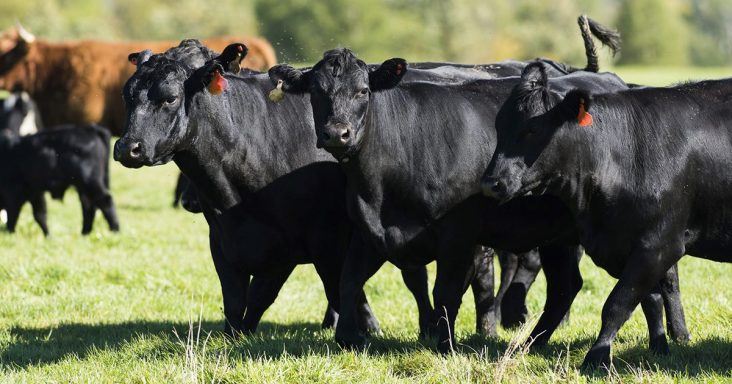USDA to investigate Tyson Foods and beef competitors on pricing practices
by August 29, 2019 1:48 pm 2,052 views

Tyson Foods and its beef processing competitors are at the center of a federal probe headed up by the U.S. Department of Agriculture (USDA) to examine the reasons behind price gaps between live cattle and finished beef.
U.S. Secretary of Agriculture Sonny Perdue ordered the investigation this week as cattle prices have continued to fall in the wake of less slaughter capacity. That comes after a devastating fire Aug. 9 that shuttered Tyson Foods’ large processing facility in Holcomb, Kan.
Cattle ranchers fear packers are paying less for their live cattle because there is one less buyer in the market. Meanwhile, packer processing margins are fat. Stephens Inc. estimated beef packer margins averaged $526 per head last week, up from $309 per head a year ago. Beef cutout values rose 12.5%, while live cattle prices were up just 1.2%. Live cattle prices have been slow to rebound despite the industry’s attempt to stabilize the market.
Packers have been buying forward lower-priced cattle to keep their processing margins averaging $300 per head during the summer months this year. That compares to $200 a year over the same period for the past five years, according to USDA data reported by Stephens.
Stephens also reported live cattle futures traded down this week at the daily limits citing weakness in future demand following the Tyson Foods fire. Stephens analysts said the market is trying to stabilize production by ramping up the capacity in other plants to try and offset the losses at Holcomb.
The biggest pricing impact has been on feeder cattle, which posted sharp losses in recent weeks. Meanwhile, Stephens notes boxed beef wholesale prices have spiked in response to reduced slaughter capacity.
Just last week, U.S. packer margins climbed to record levels as Stephens estimated between 15% to 25% of the industry beef packing capacity was lost in the Tyson Foods fire. Stephens said initial concerns over beef shortages drove a frenzy of buying activity among restaurants and retailers. That has driven up the price.
Stephens explained on the opposite side of the business, live cattle prices have dropped with one less buyer in the market.
“Stronger margins have seemingly encouraged processors to ramp beef production, particularly as the demand for beef often rises ahead of Labor Day in the U.S. Reports indicated that processors increased Saturday’s slaughter this week to 74,000 cattle from 48,000 cattle a week earlier and 67,000 cattle a year ago,” Stephens analyst Ben Bienvenue noted on Aug. 20.
The federal probe will investigate any evidence of price manipulation, collusion or unfair practices, according to a USDA statement.
“As part of our continued efforts to monitor the impact of the fire at the beef processing facility in Holcomb, Kan., I have directed USDA’s Packers and Stockyards Division to launch an investigation into recent beef pricing margins. … If any unfair practices are detected, we will take quick enforcement action. USDA remains in close communication with plant management and other stakeholders to understand the fire’s impact to the industry,” Perdue noted this week.
Tyson Foods officials said the company will cooperate with the investigation. The company has resumed some limited work at the plant this week but it will take several months to repair damage to the roof and equipment inside the plant.
Livestock marketing analyst Darrell Peel of Oklahoma State University said the probe is a response to concerns raised by cattle producers.
“I don’t think they have a choice but to launch an investigation given the backlash out in the country,” he said.
Peel notes the beef and cattle markets seem to have acted appropriately following the sudden loss of processing capacity. He estimates the daily kill at the Holcomb plant was roughly 6,000 head per day and that loss was an initial shock to the system.
“It is much like throwing a rock into a pond resulting in a big initial splash and ripple effects spreading out in all directions,” Peel said. “The initial splash of the plant closure included a dramatic set of market reactions, Peel noted.
Peel told Talk Business & Politics on Thursday (Aug. 29) the market is working to mitigate the capacity loss. While there are incentives for other packers to pick up the slack, there are also additional costs such as overtime hours, logistics of moving the cattle to a different location and the shipping of products from a different location than originally planned. He said packers are often tied to trucking contracts that can make shifting loads more expensive.
Peel said the prices are starting to settle down and the future’s markets on fed cattle are likely the last to respond given their place in the supply chain. He said the slaughter numbers just came in for the week of the fire and the following week. Peel said roughly there were just 1,000 head fewer slaughters the week following the fire given the way other plants have ramped up production.
Peel said the market reaction has been expected and the recovery plan is working.
Shares of Tyson Foods, (NYSE: TSN) traded higher on Thursday morning at $92.09, up $1.88 on normal volume. Tyson Foods shares have rebounded from the recent drops associated with trade concerns and set a new 52-week high price of $92.21 on Thursday.
The recent news of a solidified trade deal with Japan was positive for Tyson Foods and the beef industry’s rally back this week. Year-to-date Tyson Foods shares are up 75%.
